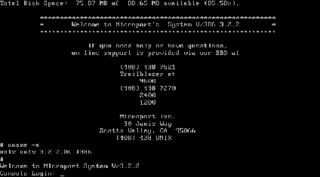Related Research Articles

AIX is a series of proprietary Unix operating systems developed and sold by IBM for several of its computer platforms.

Xenix is a discontinued version of the Unix operating system for various microcomputer platforms, licensed by Microsoft from AT&T Corporation in the late 1970s. The Santa Cruz Operation (SCO) later acquired exclusive rights to the software, and eventually replaced it with SCO UNIX.

Digital Research, Inc. was a privately held American software company created by Gary Kildall to market and develop his CP/M operating system and related 8-bit, 16-bit and 32-bit systems like MP/M, Concurrent DOS, FlexOS, Multiuser DOS, DOS Plus, DR DOS and GEM. It was the first large software company in the microcomputer world. Digital Research was originally based in Pacific Grove, California, later in Monterey, California.
Sequent Computer Systems was a computer company that designed and manufactured multiprocessing computer systems. They were among the pioneers in high-performance symmetric multiprocessing (SMP) open systems, innovating in both hardware and software.

SCO Group, Inc. v. International Business Machines Corp., commonly abbreviated as SCO v. IBM, is a civil lawsuit in the United States District Court of Utah. The SCO Group asserted that there are legal uncertainties regarding the use of the Linux operating system due to alleged violations of IBM's Unix licenses in the development of Linux code at IBM. The lawsuit was filed in 2003, it has lingered on through the bankruptcy of SCO Group and the adverse result in SCO v. Novell, and was reopened for continued litigation by order of a new judge on June 14, 2013. Pursuant to the court order reopening the case, an IBM Motion for Summary Judgment was filed based upon the results of the Novell decision. On December 15, 2014, the judge granted most of IBM's motion, thereby narrowing the scope of the case, which remained open. On March 1, 2016, following a ruling against the last remaining claims, the judge dismissed SCO's suit against IBM with prejudice. SCO filed an appeal later that month. In February 2018, as a result of the appeal and the case being partially remanded to the circuit court, the parties restated their remaining claims and provided a plan to move toward final judgement. In 2021, the case finally ended in a settlement.

The SCO Group was an American software company in existence from 2002 to 2012 that became known for owning Unix operating system assets that had belonged to the Santa Cruz Operation, including the UnixWare and OpenServer technologies, and then, under CEO Darl McBride, pursuing a series of high-profile legal battles known as the SCO-Linux controversies.
This article presents a timeline of events in the history of computer operating systems from 1951 to the current day. For a narrative explaining the overall developments, see the History of operating systems.

The Santa Cruz Operation, Inc. was an American software company, based in Santa Cruz, California, that was best known for selling three Unix operating system variants for Intel x86 processors: Xenix, SCO UNIX, and UnixWare.

The Unix wars were struggles between vendors to set a standard for the Unix operating system in the late 1980s and early 1990s.

Unix System V is one of the first commercial versions of the Unix operating system. It was originally developed by AT&T and first released in 1983. Four major versions of System V were released, numbered 1, 2, 3, and 4. System V Release 4 (SVR4) was commercially the most successful version, being the result of an effort, marketed as Unix System Unification, which solicited the collaboration of the major Unix vendors. It was the source of several common commercial Unix features. System V is sometimes abbreviated to SysV.
Trusted Operating System (TOS) generally refers to an operating system that provides sufficient support for multilevel security and evidence of correctness to meet a particular set of government requirements.
Merge is a software system which allows a user to run DOS/Windows 3.1 on SCO UNIX, in an 8086 virtual machine.

Project Monterey was an attempt to build a single Unix operating system that ran across a variety of 32-bit and 64-bit platforms, as well as supporting multi-processing. Announced in October 1998, several Unix vendors were involved; IBM provided POWER and PowerPC support from AIX, Santa Cruz Operation (SCO) provided IA-32 support, and Sequent added multi-processing (MP) support from their DYNIX/ptx system. Intel Corporation provided expertise and ISV development funding for porting to their upcoming IA-64 CPU platform, which was yet to be released at that time. The focus of the project was to create an enterprise-class UNIX for IA-64, which at the time was expected to eventually dominate the UNIX server market.

The history of Unix dates back to the mid-1960s, when the Massachusetts Institute of Technology, Bell Labs, and General Electric were jointly developing an experimental time-sharing operating system called Multics for the GE-645 mainframe. Multics introduced many innovations, but also had many problems. Bell Labs, frustrated by the size and complexity of Multics but not its aims, slowly pulled out of the project. Their last researchers to leave Multics – among them Ken Thompson, Dennis Ritchie, Doug McIlroy, and Joe Ossanna – decided to redo the work, but on a much smaller scale.
In some versions of the Unix operating system, the term universe was used to denote some variant of the working environment. During the late 1980s, most commercial Unix variants were derived from either System V or BSD. Most versions provided both BSD and System V universes and allowed the user to switch between them. Each universe, typically implemented by separate directory trees or separate filesystems, usually included different versions of commands, libraries, man pages, and header files. While such a facility offered the ability to develop applications portable across both System V and BSD variants, the requirements in disk space and maintenance gave them a problematic reputation. Systems that offered this facility included Harris/Concurrent's CX/UX, Convex's Convex/OS, Apollo's Domain/OS, Pyramid's DC/OSx, Concurrent's Masscomp/RTU, MIPS Computer Systems' RISC/os, Sequent's DYNIX/ptx and Siemens' SINIX.

Microport Systems (1985–2002) was a software development group that pioneered a new approach towards software ports that dramatically reduced development costs and, consequently, the price charged for UNIX. Microport created the first ports of AT&T's UNIX System V for the IBM 286 and 386 personal computers, as well as IBM's PS/2 systems. Microport was critical to enabling the Free Software Foundation (FSF) to port its GNU C compiler (gcc) and associated utilities, onto the x86 architecture by donating a complete 386 development system to the Richard Stallman-led group. Microport also played a key role in Kevin Mitnick's first arrest, after he broke into the internal computer networks of both Microport and The Santa Cruz Operation.
Locus Computing Corporation was formed in 1982 by Gerald J. Popek, Charles S. Kline and Gregory I. Thiel to commercialize the technologies developed for the LOCUS distributed operating system at UCLA. Locus was notable for commercializing single-system image software and producing the Merge package which allowed the use of DOS and Windows 3.1 software on Unix systems.

A Unix-like operating system is one that behaves in a manner similar to a Unix system, although not necessarily conforming to or being certified to any version of the Single UNIX Specification. A Unix-like application is one that behaves like the corresponding Unix command or shell. Although there are general philosophies for Unix design, there is no technical standard defining the term, and opinions can differ about the degree to which a particular operating system or application is Unix-like.
References
- ↑ "New Version of IBM DB2 Universal Database". May 17, 1999. Archived from the original on June 1, 2019.
- ↑ "Emerging Technologies Multi/Parallel Processing" (PDF).
- ↑ DYNIX/ptx System Administration Guide, Volume 1 (1003-59809-00). Sequent Computer Systems, Inc.
- ↑ "The system we investigated was a NUMA-Q 2000 System from IBM running a proprietary, System V based, operating system DYNIX/ptx."Mohamed Ibrahim; Josef Küng; Norman Revell (2000). Database and Expert Systems Applications: 11th International. ISBN 3540679782.
- ↑ "SCO pulls second IBM Unix license". CNET.
- ↑ "IBM drops Intel high-end server". Computerworld. May 13, 2002.
- ↑ "Sequent "Project Monterey" Road Map". Computerworld. February 1, 1999. p. 28.
- ↑ "Caldera loads Linux apps on UnixWare". ZDNet .